trunk AUDI Q7 2011 Owner´s Manual
[x] Cancel search | Manufacturer: AUDI, Model Year: 2011, Model line: Q7, Model: AUDI Q7 2011Pages: 392, PDF Size: 93.29 MB
Page 11 of 392
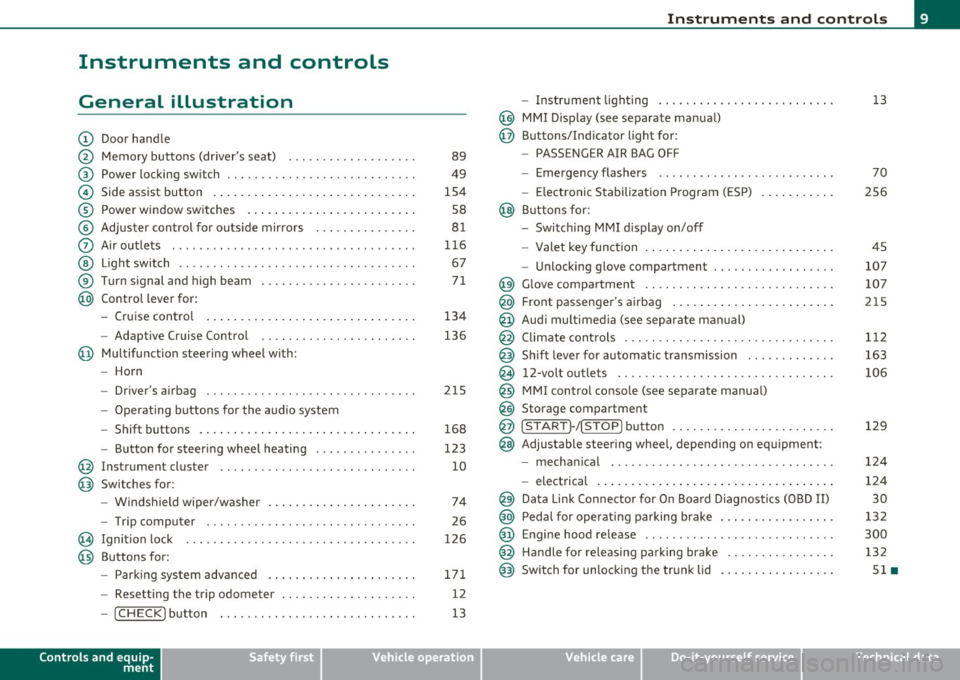
Instruments and controls
General illustration
(D Door handle
@ Memory buttons (driver's seat) .................. .
@ Power locking sw itch ........................... .
© Side assist button ... .. ... ... ... .. .. .. ... . .. ... .
® Power window sw itches ... .... .. .. .. .. .. ... ... . .
© Adjuster con trol for outs ide mir rors .............. .
0 Air outlets .......... .... .. .... ............... .
@ Light switch ...... .. .... ... .. .. .. ... ... .. .. ... .
® Turn s ignal and high beam ...................... .
@ Control lever for:
- Cru ise control . .... ... ... .. .. .. .. .. .. .. .. ... .
-Adaptive Cruise Control .. .. ................ .. .
@ Mu ltifunction steering wheel with:
- Horn
- Driver's airbag .............................. .
- O pera ti ng butto ns for the audio system
- Shift buttons . ... .. .. .. .... .. .. .. .. .. ...... . .
- Button for steer ing whee l heating ..... ... ...... .
@ Instrument cluster ............................ .
@ Switches for:
- Windshield wiper/washer ... ...... .. ..... .... . .
- Trip computer .............................. .
@ Ignition lock ................................. .
@ Buttons for:
- Par king sys tem advance d .... ..... .. .. ... .. .. . .
- Resetting the trip odometer ................... .
- ICHECK ]button ......................... ... .
Controls and equip
ment Safety first
89
49
1S4
S8
8 1
11 6
67
7 1
134
136
2 1S
168
123
10
74
26
126
171 12
13
Instruments and controls
- Instr ument lighting ......................... .
@ MMI Disp lay (see separate ma nual)
@ Buttons/Indicator light for:
- PASSENGER AIR BAG OFF
- Emergency flashers ...... .. ................. .
- Electroni c Stabilization Progr am ( ESP)
@ B uttons for:
- Switching MMI d isplay on/off
- Valet key function .. .. .. .. .. .. .. ...... ... .. .. .
- Unlocking g love compartment ................. .
@ Glove compartment ........................... .
@ Front passenger's airbag ...... ..... .. ..... .. .. . .
@ Audi mu ltime dia (see separate man ual)
@ Climate cont rols .............................. .
@ Shift leve r for automatic transmission ............ .
@ 12-volt outlets ............................... .
@ MMI contro l console (see separate manua l)
@ Storage compartment
@ ISTART]-/ISTOP] button ....................... .
@ Adjustable stee ring whee l, depending on eq uipme nt:
- mecha nical .... .. .... ... .. .. .. ... .... ..... . .
- electrical ..... . ... .. .. .. .... .... .. .. .. ... .. .
@ Da ta Lin k Connecto r for On Boa rd Diagnos tics (OBD II)
@ Peda l for operating pa rking brake ................ .
@ Engine hood release ............. ... .. ......... .
@ Handle for releasing parking brake ............... .
@ Switch for unlocking the trunk lid ................ .
Vehicle care
13
70
2S6
45
107
107
215
1 12
163
106
129
12 4
124
30
13 2
300
132
Sl •
Technical data
Page 26 of 392

Driver information display
Digital speedometer
Fig. 11 Display:
Digita l speedomet er
Current speed appears in the display. Speed is shown in 1 mph
measures (USA models) or 1 km/h measures (Canada models) .
You ca n sw itch the display from miles to kilometers and vice versa via
the MMI. •
Open door or trunk lid warning
The pictogram alerts you when doors or the rear lid have
been left open.
Fig. 12 Display: open
d oo r or rear lid
warning
With the ignition switched on, the open door or rear lid warning illu
minates when at least one door or the hood or the trunk lid is not
closed. The symbol also shows you
which door(s) or lid is not closed.
In the illustration ~ fig. 12 it is the driver's door, the left rear door
and the rear lid. As soon as all the doors, the hood, the rear lid and
the fuel filler cap are properly closed, the door and rear lid warning
turns off and the Driver Information System functions selected are
displayed again. •
Defective light bulb warning
The defective light bulb warning tells you when a vehicle
light bulb has become defective .
Fig. 13 Display : defec
tive light bulb warning
The defective light bulb warning monitors the function of the light
bulbs. If this symbol illuminates, a brake light, a turn signal (front
or rear), a headlight, the backup light, a fog light or a rear fog light
has failed .
& WARNING
• Light bulb s are pressurized and could explode while they are
being changed causing serious personal injury. .,._
Page 54 of 392
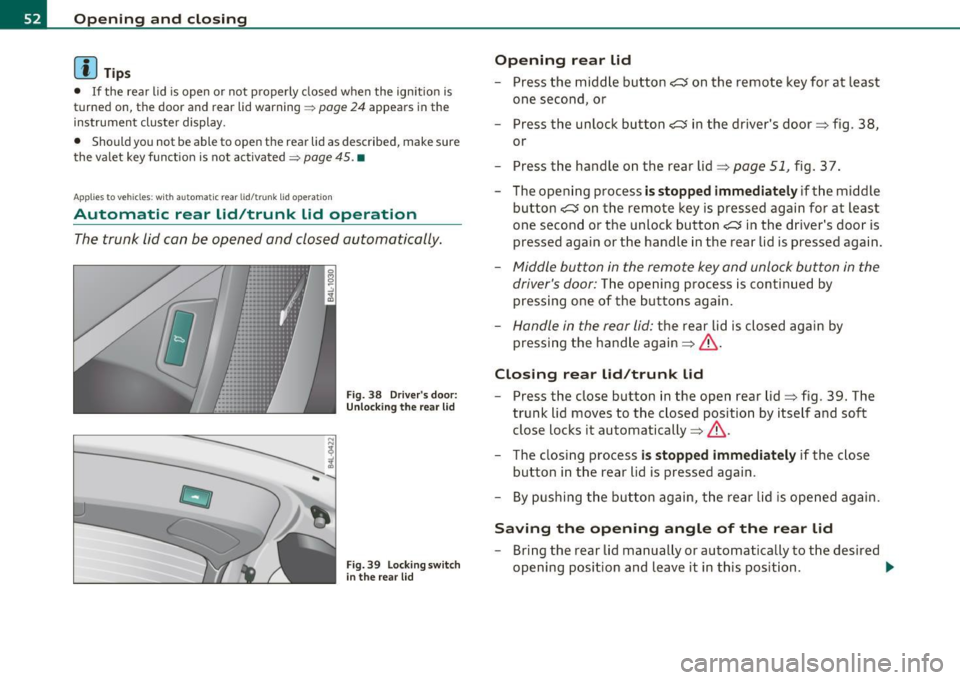
Open ing and closing
(I) Tip s
• If the rear lid is open or not properly closed when the ignition is
turned on, the door and rear lid warning ~
page 24 appears in the
instrument cluster display.
• Should you not be able to open the rear lid as described, make sure
the valet key function is not activated~
page 45. •
App lies to veh icles: with automatic rear lid /trunk lid ope rat ion
Automatic rear lid/trunk lid operation
The trunk lid can be opened and closed automatically.
F ig. 38 Drive r's door:
Unlocki ng the re ar lid
F ig. 39 Lock ing sw itch
i n t he rear lid
Op ening rear lid
- Press the middle button e:> on the remote key for at least
one second, or
- Press the unlock button
e:> in the driver's door=> fig . 38 ,
or
- Press the handle on the rear lid=>
page 51, fig. 37.
- The opening process
is stopped immediate ly if the middle
button
e:> on the remote key is pressed again for at least
one second or the unlock button
e:> in the driver's door is
pressed again or the handle in the rear lid is pressed again .
-Middle button in the remote key and unlock button in the
driver's door:
The opening process is continued by
pressing one of the buttons again .
Handle in the rear lid: the rear lid is closed again by
pressing the hand le again =>& .
Closing rear lid /trunk lid
Press the close button in the open rear lid=> fig . 39. The
trunk lid moves to the closed position by itself and soft
close locks it automatically =>& .
- The closing process
i s stopped immediately if the close
button in the rear lid is pressed again.
- By pushing the button again, the rear lid is opened again.
Saving the opening angle of the rear lid
- Bring the rear lid manually or automatically to the desired
opening position and leave it in this position. ..,_
Page 56 of 392
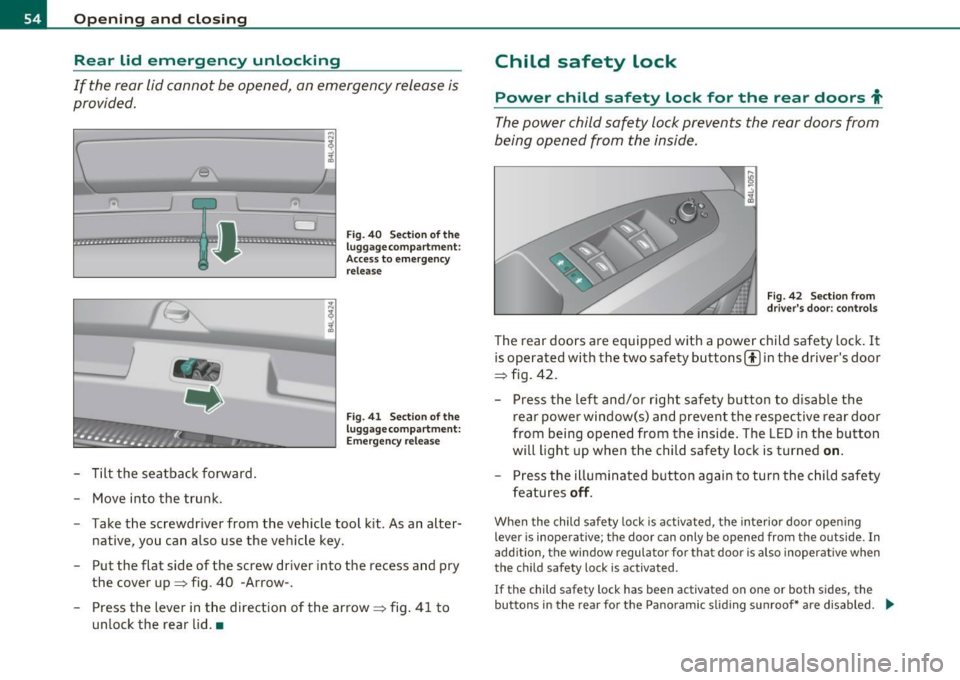
Open ing and closing
Rear lid emergency unlocking
If the rear lid cannot be opened, an emergency release is
provided.
-------------------! ~ ~ -;[,
D
~ ................... -.. -.. -
- Tilt the seatback forward.
- Move into the trunk.
Fig. 40 Sect ion of the
luggage compartment:
Access to eme rgency
release
Fig. 41 Section of the
luggage compartment :
Emergency re lease
- Take the screwdriver from the vehicle tool kit. As an alter-
native, you can also use the vehicle key.
- Put the flat side of the screw driver into the recess and pry
the cover up=> fig. 40 -Arrow-.
- Press the lever in the direction of the arrow~ fig. 41 to
unlock the rear lid .•
Child safety lock
Power child safety lock for the rear doors t
The power child safety lock prevents the rear doors from
being opened from the inside .
Fig. 42 Sect ion from
drive r's door: controls
The rear doors are equipped with a power child safety lock . It
is operated with the two safety buttons(!) in the driver's door
~fig. 42.
- Press the left and/or r ight safety button to d isable the
rear power window(s) and prevent the respective rear door
from being opened from the inside . The LED in the button
will light up when the child safety lock is turned
on.
Press the illuminated button again to turn the child safety
features
off.
When the child safety lock is activated, the interior door open ing
lever is inoperative; the door can only be opened from the outside. In
add ition, the window regulator fo r that door is also inoperative when
the child safety lock is activated.
If the child safety lock has been activated on one or both sides, the
buttons in the rear for the Pa noramic slid ing sunroof* are disabled. .,
Page 185 of 392

____________________________________________ A_ d_a_ p ,_ t_iv _ e_ A _ i_ r _ S_ u_s_, p __ e_n _ s_ i _o_ n __ _
ically raised to high level 1 again when the traveling speed falls below
approximately 25 mph (40 km/h) .
Restrictions when operating with a trailer
When operating with a trailer, the lift mode can only be selected up
to about 12 mph (20 km/h). Lift mode is automatically canceled
agai n when a speed of about 25 mph (40 km/h) is exceeded.
If the vehicle is in automatic , comfort, offroad or lift mode before the
trailer towing mode is activated, the dynamic mode cannot be acti
vated .
If the vehicle is in dynam ic mode before towing operation is acti
vated, it can be driven in this mode. If the suspension is switched
from th is mode to another mode, dynamic mode cannot be re
selected.
[I) Tips
• For vehicles with a factory installed towing hitch or a trai ler hitch
that was installed later according to factory specifications, the
system recognizes "Trailer towing mode" and activates this specia l
mode automat ically , as soon as the electr ical connection on the
trailer socket is connected. The mode ceases automatically when the
electrical connection to the trailer socket is disconnected.
• If the trai ler towing mode has been activated, the vehicle will not
drop to the low o r highway level. •
Controls and equip
ment Safety first
A
pp lies to vehicles : w ith Adapt ive Air Sus pens ion
Cargo mode
The rear of the vehicle can be lowered to make it easier to
load .
Fig. 182 Luggage
compartment detail:
Cargo mode switch
Activating cargo mode in the MMI
-Select: Function button [CARI> function button [SETUP)
> Lower for loading.
Using switch for activating cargo mode
- Close all vehicle doors.
- Open the trunk lid.
- Press the lower part of the switch ®~ fig. 182. The rear
of the vehicle is lowered.
- Press the upper part of the switch
(D. The rear of the
veh icle is raised again.
In cargo mode, the rear axle is lowered by 2.2 inches (55 mm),
compa red to the normal level.
While the vehicle is in cargo mode, the segments do not appear as
filled in the segment d isplay. .,,
Vehicle care Technical data
Page 186 of 392
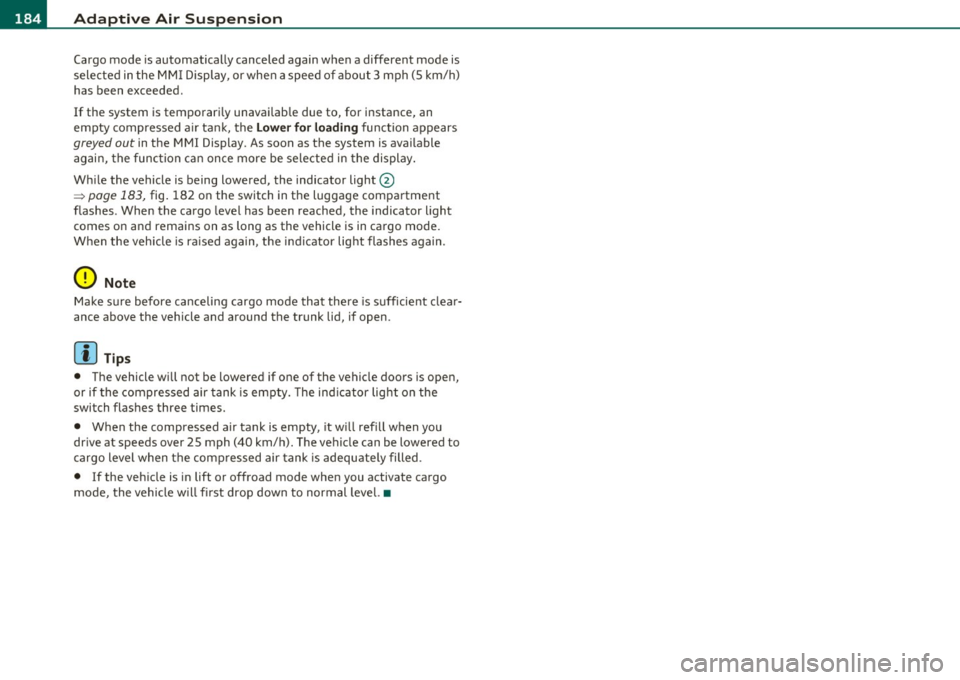
1111....__A_ d_ a_,_ p_t _i_ v _e _ A_i_ r_ S_ u_ s ... p,_ e_n_ s_ io_ n __________________________________________ _
Cargo mode is automatically canceled again when a different mode is
selected in the MMI Display, or when a speed of about 3 mph (5 km/h)
has been exceeded .
If the system is temporarily unavailable due to, for instance, an
empty compressed air tank, the
Lower for loading function appears
greyed out in the MMI Display. As soon as the system is available
again, the function can once more be selected in the display.
While the vehicle is being lowered, the indicator light®
~ page 183, fig. 182 on the switch in the luggage compartment
flashes . When the cargo level has been reached, the indicator light
comes on and remains on as long as the vehicle is in cargo mode.
When the veh icle is ra ised again, the indicator light flashes again .
0 Note
Make sure before ca nceling cargo mode that there is sufficient clear
ance above the vehicle and around the trunk lid, if open.
(I) Tips
• The vehicle will not be lowered if one of the vehicle doors is open,
or if the compressed air tank is empty. The ind icator light on the
switch flashes three times.
• When the compressed air tank is empty, it will refill when you
drive at speeds over 25 mph (40 km/h). The vehicle can be lowered to
cargo level when the compressed air tank is adequately filled.
• If the vehicle is in lift or offroad mode when you activate cargo
mode, the vehicle will first drop down to normal level.•
Page 297 of 392
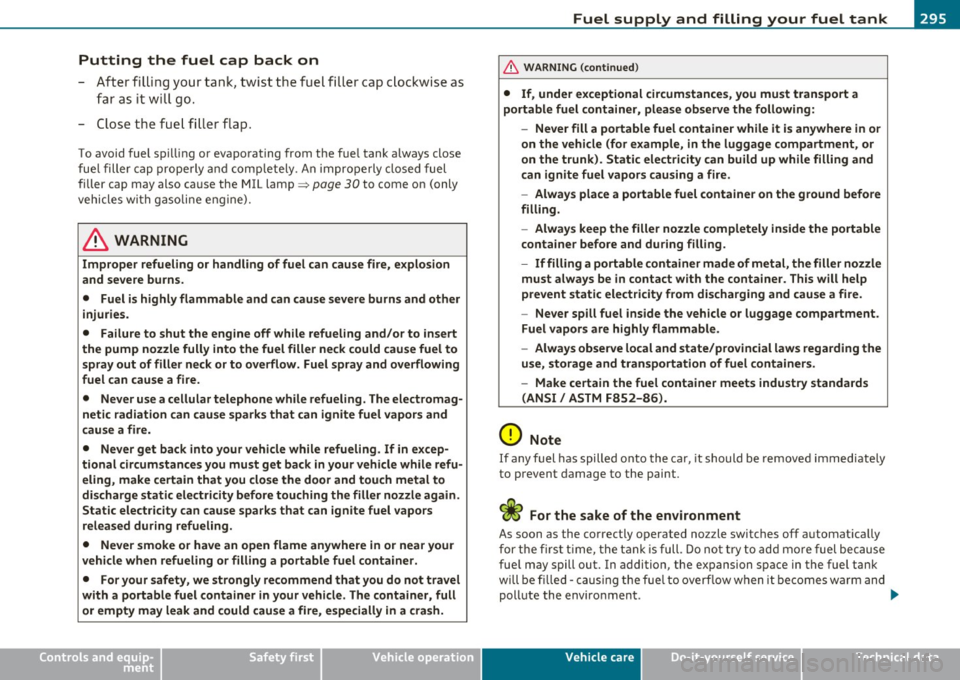
Putting the fuel cap back on
- After filling your tank, twist the fuel fi ller cap c lockwise as
f ar as it w ill go.
- Close t he fue l fi ller flap.
To avoid fuel spi lling or evapo rating from the f uel tank a lways close
fue l filler cap properly and comp lete ly . An impro perly closed fuel
filler cap may also ca use the MIL lamp~
page 30 to come on (only
vehicle s wi th gaso lin e e ngine).
& WARNING
Improper refueling or handling of fuel can cause fire, explosion
and severe burns .
• Fuel i s highly flammable and can cause severe burns and other
injuries.
• Failure to shut the engine off while refueling and /or to insert
the pump nozzle fully into the fuel filler neck could cause fuel to spray out of filler n eck or to overflow. Fuel spray and ov erflowing
fuel can cause a fire.
• Never use a cellular telephone while refueling. The electromag
netic radiation can cau se sparks that can ignite fuel vapors and
cause a fire.
• Never get back into your vehicle while refueling. If in excep
tional cir cumstan ces you must get ba ck in your v ehicle while refu
eling, make certain that you close the door and touch metal to
discharge static electricity before touching the filler nozzle again .
Static electricity can cause sparks that can ignite fuel vapo rs
released during refueling.
• Never smoke or have an open flame anywhere in o r near your
vehicle when refueling or filling a portable fue l container.
• For your safety , we strongly recommend that you do not travel
with a portable fuel container in your vehicle . The container , full
or empty may leak and could cau se a fire , especially in a crash.
Safety first
Fuel supply and filling your fuel tank
& WARNING (co ntinued )
• If, under exceptional circumstances , you must tran sport a
portable fuel container, please observe the following:
-Never fill a portable fuel container while it is anywhere in or
on the vehicle (for example, in the luggage compartment, or
on the trunk ). Static electricity can build up while filling and
can ignite fuel vapors causing a fire .
- Always place a portable fuel container on the ground before
filling .
- Always keep the filler nozzle completel y inside the portable
container before and during filling.
- If filling a portable container made of metal, the filler nozzle must always be in contact with the container. This will help
prevent static ele ctricity from discharging and cause a fire .
- Ne ver spill fuel inside the vehicle or luggage compartment .
Fuel vapor s are highly flammable.
- Always observe local and state /provincial laws regarding the
use, storage and tran sportation of fuel containers .
-Make certain the fuel container meets industry standards
( ANSI / ASTM F852-86 ).
0 Note
If any f uel has spilled o nto the ca r, it should be remove d immed iate ly
to prevent damage to the paint.
f or t he firs t time, the t ank i s full. Do no t try to ad d mo re fuel bec ause
fue l may spill out. In addition, the expansion space in the fuel tank
w ill be fi lled -caus ing the fue l to overf low when it becomes wa rm and
poll ute the enviro nment . .,_
Vehicle care Technical data
Page 383 of 392
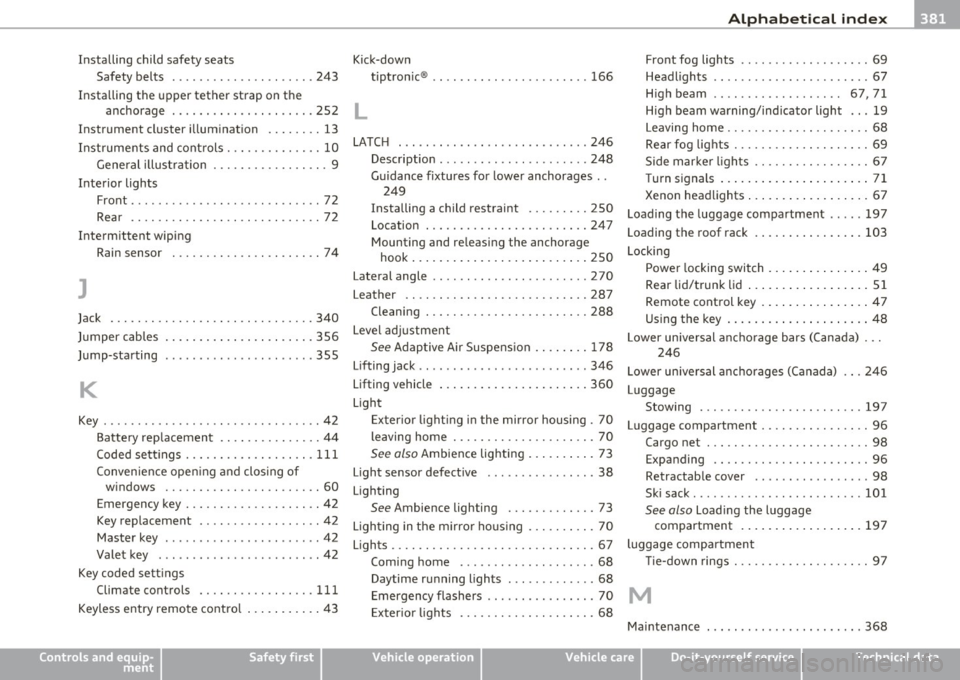
_____________________________________________ A_ L .... p_ h _ a_b_ e_ t_ ic_a_ l_ in_ d_e _ x __ _
Installing child safety seats
Safety belts ............. ........ 243
Installing the upper tether strap on the
anchorage .......... ... ... ..... 252
Instrument cluster illumination ........
13
Instruments and controls ... ....... .... 10
General illustration ............ .. .. . 9
Interior lights Front . .. ..... ....... .... ... .. .. .. 72
Rear ............................ 72
Intermittent wiping
Rain sensor ........ ...... .. .. .. .. 74
J
Jack .............................. 340
Jumper cables ........ ... ... ... ..... 356
Jump-starting .............. ... ..... 355
K
Key ...... ..... ..... .. .. .. .. .. .. .. .. 42
Battery replacement .. .. .. .. ....... 44
Coded sett ings ...................
111
Convenience open ing and closing of
windows .......................
60
Emergency key ................ .. .. 42
Key replacement ............. .... . 42
Master key .............. ......... 42
Valet key ........................ 42
Key coded settings
Climate controls .................
111
Keyless entry remote control ... .. ...... 43
Controls and equip
ment Safety first
Kick-down
tiptron ic ® . ................ ......
166
L
LATC H ....... ..... ........ ........ 246
Description .. ... .... .. .. .. ... .... 248
Guidance fixtures for lower anchorages ..
249
Installing a child restraint ......... 250
Location ..... ........... ...... .. 247
Mounting and relea ,sing the anchorage
hook ........................ .. 250
Lateral angle ....... ... .. .. ......... 270
Leather ...... .. .. ...... ........... 287
Cleaning ..... ........... ........ 288
Level adjustment
See Adaptive A ir Suspens ion ........ 178
Lifting jack .. .......................
346
Lifting vehicle ...................... 360
Light
Exterior lighting in the mirror housing . 70
leaving home . ................. .. . 70
See also Ambience lighting ...... .. .. 73
Light sensor defective ...... ...... ... . 38
Lighting
See Ambience lighting ............. 73
L ighting in the m irror hous ing ..........
70
Lights ..................... .. .. .. .. . 67
Coming home ......... . ... .. .. ... 68
Daytime running lights ............. 68
Emergency flashers ................ 70
Exterior lights .................... 68 Front
fog lights .......... ...... ...
69
Headlights ................... ... . 67
High beam ................... 67, 71
High beam warning/indicator light ... 19
Leaving home ................... .. 68
Rear fog lights ...... ...... .... .. .. 69
Side marker lights .................
67
Turn signals ...................... 71
Xenon headlights ... ... ... ......... 67
Loading the luggage compartment ..... 197
Loading the roof rack .............. .. 103
Locking
Power locking switch ...... ..... .. .. 49
Rear lid/trunk lid ... ............... 51
Remote control key ... ..... .. .. .. .. 47
Using th e key ........ .... ..... .. .. 48
Lower universal anchorage bars (Canada) .. .
246
Lower universal anchorages (Canada) .. . 246
L ug gage
Stowing ............ ... .. .. .....
197
Luggage compartment ................ 96
Cargo net . .. ...... ............... 98
Expanding .. ...... ............... 96
Retractable cover ................. 98
Sk i sack ....... .... .. . .. .. .. .. .. .
101
See also Loading the luggage
compartment ................ .. 197
luggage compartment Tie-down rings .................. .. 97
M
Maintenance . .... .. .. ..... ..... ... . 368
Vehicle operation Vehicle care Do-it-yourself service Technical data
Page 385 of 392

_____________________________________________ A_ L .... p_ h _ a_b_ e_ t_ ic_a_ l_ in_ d_e _ x __ _
Pollen filter
Climate controls ......... ... ..... 111
Power locking switch ............ ... .. 49
Power locking system ................ . 46
Convenience close/open feature .. .. .. 60
Locking and unlocking the vehicle from
inside ...... ...... .. .. .. .. .... .. 49
Opening and closing the windows .... 60
Rear lid/trunk lid ......... ... ...... 51
Remote control key .......... ...... 43
Select ive unlock feature ........ .. .. 49
Sett ings ..................... .. .. 49
Unlocking and locking vehicle .... .. .. 47
Power outlets ............. .. .. .. .. . 106
Power seat Controls ... ................. ... .. 86
Seat adjustment ...... .... .. .. .. .. 86
Power steering .......... .. .. .. .... . 261
Power window switches .... .. ... ...... 58
In the driver 's door ....... .... ... .. 58
In the front passenger 's door ....... . 59
Reactivating the system ...... .. .. .. 61
Pregnant women Special considerations when wearing a safety belt .......... .. .. .. .... . 207
Programming the Homelink ® universal re-
mote control ................ ... 185
Proper occupant seating pos it ions . .. .. . 192
Proper safety belt position ....... .. .. . 206
Proper seating position
Front passenger .. .... .. .......... 193
Occupants ......... .. ... ..... ... 192
Rear passengers . ..... ........ .... 194
Controls and equip
ment Safety first
Protective tray
... .. ..... .... ... ..... . 99
Q
Quartz clock ...... .................. 11
quattro ®
See All Wheel Drive ............... 262
Question What happens to unbelted occupants? ..
203
Why safety belts? ................ 201
R
Radiator fan .. .. .. ................. 311
Rain sensor ................. ..... ... 7 4
Rain sensor defective ............. ... . 38
Reading lights Front . ................. .. .. .. .. . 72
Rear .. .. .. .. ... ........ ...... .. . 72
Rear ashtray .. .. .. .... ... .......... 105
Rear fog lights .. .. ... ...... .. .. .. .. . 69
Rear lid Automatic operation ............ .. . 52
Emergency unlocking .. .. .......... 54
Opening and closing ............ ... 51
Valet key function ...... ... ........ 45
Rear light
Defective .... .. ... ............... 24
Rear ope ration
Four-zone automatic comfort air
condi tioning ................. .. 121 Rear park assist ...
....... ... ... .. .. . 170
Adjusting the display ....... .. .. ... 176
Adjusting the warning tones ........ 176
Trailer hitch . .. .. .. .. .. ... ..... .. 177
Rear seats Adjusting seat ...... ...... .. . ... .. 90
Entry assist ... .. .. ............... 91
Folding seatback up and down .. ... .. 92
Rear view camera
Parking mode 1 ................ .. 174
Parking mode 2 ................ .. 175
Rear view mirror
Inside rear view mirror . . . . . . . . . 79, 80
Rear window defogger ............. .. 115
Red symbols ........................ 33
Refue lling ... .... ........... .... .. . 294
Gasoline inhibitor flap ............. 294
Release lever for hood . ....... .. .. .. . 300
Remote control garage door opener
(Homelink ®) ........... ... .. ... 185
Remote control key ................... 43
Unlocking and locking .............. 47
Remote rear lid release ............... 51
Repair manuals ..... .... ... .. .. .. ... 368
Repairs Airbag system ................ ... 225
Replacing a fuse ......... .. .. .. .. .. . 350
Replacing light bulbs .. .. .. .......... 354
Replacing tires and wheels ............ 330
Report ing Safety Defects ............. 199
Reset button ...... . .. ............... 12
Residual heat .. .. .. .. .............. 112
Vehicle operation Vehicle care Do-it-yourself service Technical data
Page 388 of 392
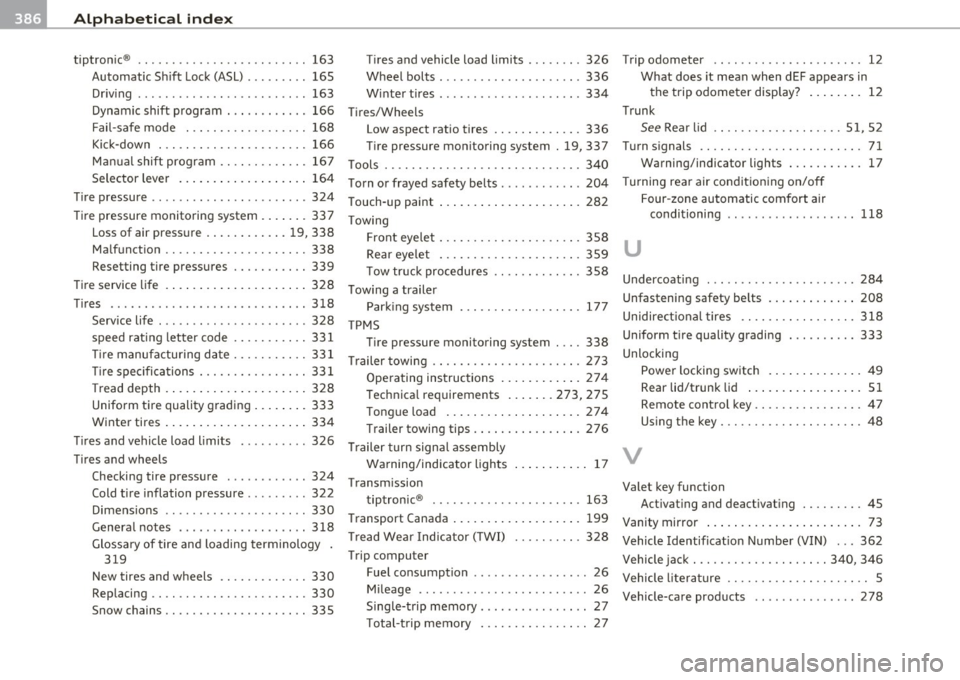
___ A_ l_. p_ h _ a_b_ e_ t_ic _a_ l_ in_ d_e _ x ____________________________________________ _
tiptronic ® . .... .... ..... ... .. ... . .. 163 T ires and vehicle load limits . .. .. .. . 326
Automatic Sh ift Lock (ASL) ...... ... 165 W heel bolts ................... .. 336
Dr iv ing .................. .... ... 163 Winte r tires ............... ... .. . 334
Dynamic shift program . .. .. ... . ... 166 T ires/Wheels
Fai l-safe mode . .. ............. ..
168 Low aspect ratio tires .. .. .. .. .. ... 336
Ki ck-down ... .. .. .. .. .. .... ..... 1 66 T ire pressure monitoring system . 19,337
Ma nual shift program .... ......... 1 6 7 Tools ............ .. .. .. .... .. .. ... 34 0
Selector lever .. .. ... . ..... .. . ... 164 Torn or frayed safety be lts .......... .. 20 4
Tire pressure ........ ... ... ..... .... 324 Touch-up paint ... .. .... .. .. .. .... .. 282
Ti re pressure monitoring system . ... .. . 337
Loss of air press ure . .... ... ... . 19, 338
Ma lf u nct ion ................... .. 338
Resetting t ire pressures ......... .. 339
T ow ing
Front eye le t .............. ...... .
358
Rear eye let .............. .. .. .. . 359
T ow tr uck procedures .. .... .. ..... 358
Ti re service life .... .. .. .. .... ... .. .. 328 T ow ing a tra ile r
T ires ...... .............. ...... ...
3 18 Par king system . .. .... .... .. .... . 177
Service life ... .. .. .. .. ... .... .... 328 TPMS
speed rat ing let ter code ......... .. 3 31
Tir e m anufactur ing da te ..... ......
331
Tir e spe cifica tions . .. ........... .. 3 31
Tr ead depth . ... .. .. ... ... .... ... 328
Uniform t ire quali ty g rading ... .. .. . 33 3
Winter tires . ... .... .. .. .. .. .. . .. 334
Tir es and vehicle load limits . .. .... ... 326
Tires and wheels T
ire pressure monitoring system . ... 338
Tr ailer towi ng .. .. ................. .
273
Ope rating instruc tions ...... .... .. 2 74
T ech nica l requirements ... .. .. 273, 275
T ong ue load .... ... ...... .. .. ... 274
T railer towing tips . ... ...... .. ... . 276
Tr ailer turn sign al assembly
Wa rning/indicator l igh ts ... .. .... ..
1 7
Checking tire pressure ............ 324
Cold tire inflation pressure .. .... ... 322
Dimensions .. ............ .... ... 330
General notes ..... ...... .... .... 318
Gl f t.
d l d" t . l Tread We ar Indic a tor (lfWI) ... .... .. . 328 ossa ry o ,re an oa mg ermmo ogy .
319
Transm ission
t . t
. ® ,p ronic ............ ...... ... .
T ransport Cana da ...... ..... ... .. .. . 163
199
Trip computer
New tires and wheels .... .........
330 Fuel co nsump tion ........ ...... .. . 26
Rep lacing .. .. .. .. ...... ......... 330 Mileage ............ ... .. ... ..... 26
Snow chains .. ..... ....... .... . .. 335 Single-trip memory ................ 27
T otal -t rip me mory ........ .... .. .. 27
Trip odometer . . . . . . . . . . . . . . . . . . . . . . 12
What does it mean when dEF appears in
t he trip o dome ter display? . . . . . . . .
12
Trunk
See Rea r lid .. ... ... ........... 51 , 52
Turn s ignals .... ....... ...... .. .... . 71
Warning/indicator lights . .......... 17
T urning re ar air condit io ni ng on/off
F our -zone automatic comfort air
conditioning .. ................ .
118
u
Undercoating ... .. .. .. ... ..... .. .. . 284
Unfastening safety be lts ...... ... .. .. 208
Unidire ct io nal tires .. .. .. .. .... .. ... 318
Un iform t ire quali ty grading .......... 333
Unlocking
Power locking switch . ... ... ... .. ..
49
Rear lid/trun k lid ... .. .. .. ...... .. 5 1
Remote control key .. ............. . 47
Using the key .............. .... .. . 48
V
Valet key function
Activat ing and deact ivat ing ........ .
45
Vanity mirror ... .. .. .. ... .... ..... .. 73
Vehicle Identificat ion Numbe r (V IN) ... 362
Vehicle jack . .. .. ....... ...... .. 340, 346
Vehicle lite ratu re . . . . . . . . . . . . . . . . . . . . . 5
Vehicle-care products ...............
278